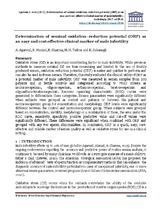| dc.description.abstract | Oxidative stress (OS) is an important contributing factor to male infertility. While previous methods to measure seminal OS are time-consuming and limited to the use of freshly produced semen, oxidation reduction potential (ORP) is easier and quicker to perform and can also be used in frozen semen. Therefore, this study evaluated the clinical utility of ORP as a potential marker of male infertility. ORP was measured in semen samples from 293 patients and 15 fertile controls and categorised according to WHO criteria as normozoospermic, oligozoospermic, asthenozoospermic, teratozoospermic and oligoasthenoteratozoospermic. Receiver operating characteristic (ROC) curves were generated to differentiate these categories. Semen parameters were significantly different when subjects were grouped as control and patients or between the patient and normozoospermic group for concentration and morphology. ORP levels were significantly different between the control and normozoospermic group. When subjects were grouped based on concentration, motility, morphology or a combination of these, the area under the ROC curve, sensitivity, specificity, positive predictive value and cut-off values were significantly different. These differences were significant when combined with ORP and grouped with any two sperm abnormalities. In conclusion, ORP is a quick, easy, cost-effective and reliable marker of semen quality as well as oxidative stress for use in a clinical setting. | en_US |

